Spatiotemporal Analysis of Heavy Metal Water Pollution in Transitional China
Abstract
:1. Introduction
2. Experimental Section
2.1. Study Area
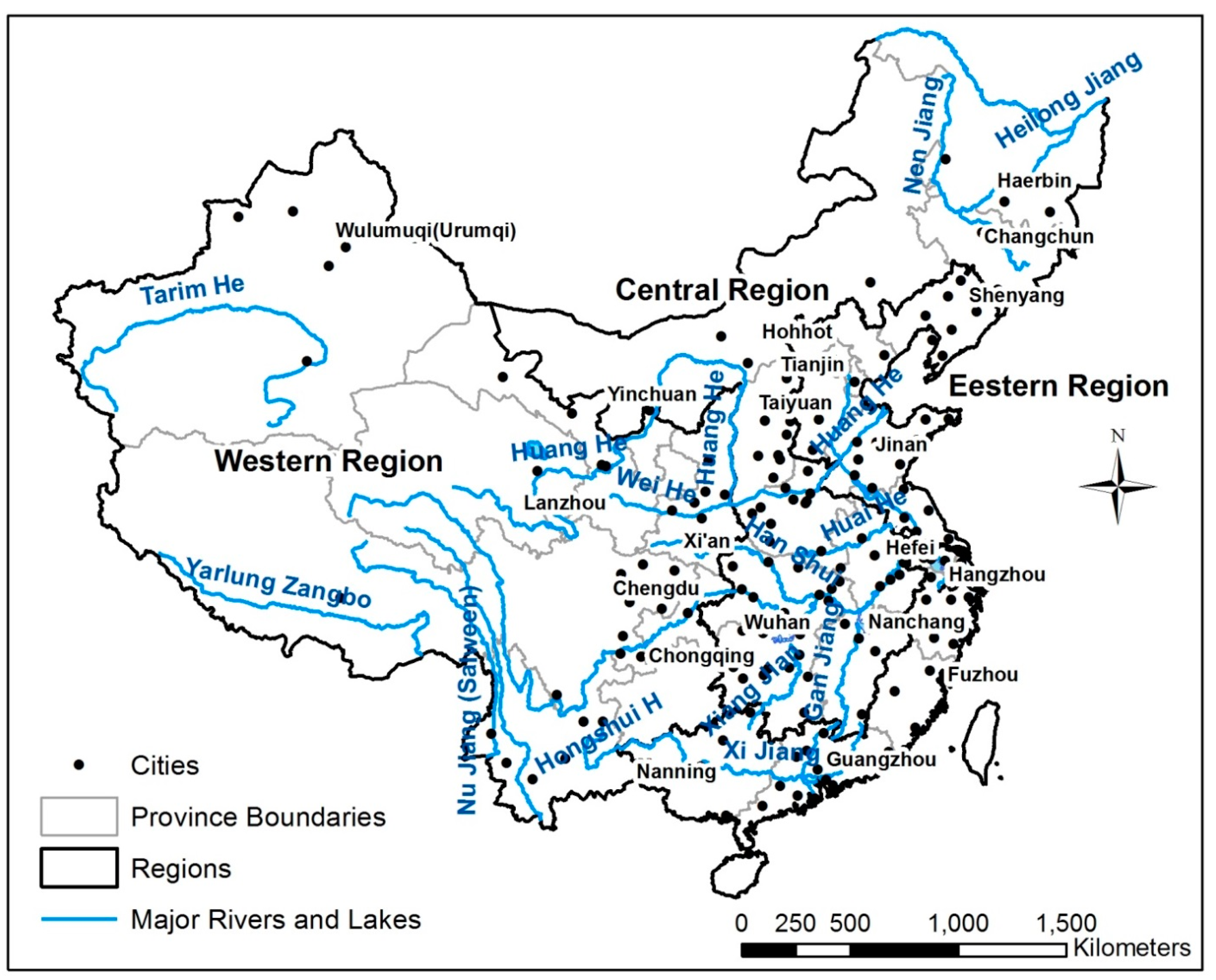
2.2. Data and Data Sources
| Classes | Variables | Indicators | |
|---|---|---|---|
| Dependent Variable | Heavy metal pollutants in 2011 | As, Cr, Hg, Cd and Pb | |
| Independent Variables | Socioeconomic Transitions | Industrialization | Gross industrial output of enterprises above designated size/total industrial output (IND); Mining and quarrying employers (MQ); Total passenger traffic (TRA) |
| Urbanization | Non-agricultural population (URB) | ||
| Globalization | Foreign direct investment capital (GLO) | ||
| Economic Development | GDP per capita (ECO) | ||
| Physical conditions | Green land (GRE) | Percentage of green area | |
| Hydrology (HYD) | Upper, middle and lower reaches | ||
| Natural Resources (NR) | Coal, Chromite, Lead, Petroleum, Pyrite and Zinc | ||
2.3. Methods
3. Results and Discussion
3.1. Spatial and Temporal Variations of Heavy Metal Water Pollution
| As | Cd | Cr | Hg | Pb | |
|---|---|---|---|---|---|
| 1 | Chenzhou | Kunming | Jiaozuo | Zhuzhou | Kunming |
| 2 | Kunming | Luoyang | Xiangtan | Nantong | Shaoguan |
| 3 | Lhasa | Chenzhou | Nanchang | Chifeng | Chenzhou |
| 4 | Jinchang | Shaoguan | Quanzhou | Chenzhou | Luoyang |
| 5 | Chifeng | Jinchang | Guangzhou | Shenzhen | Zhuzhou |
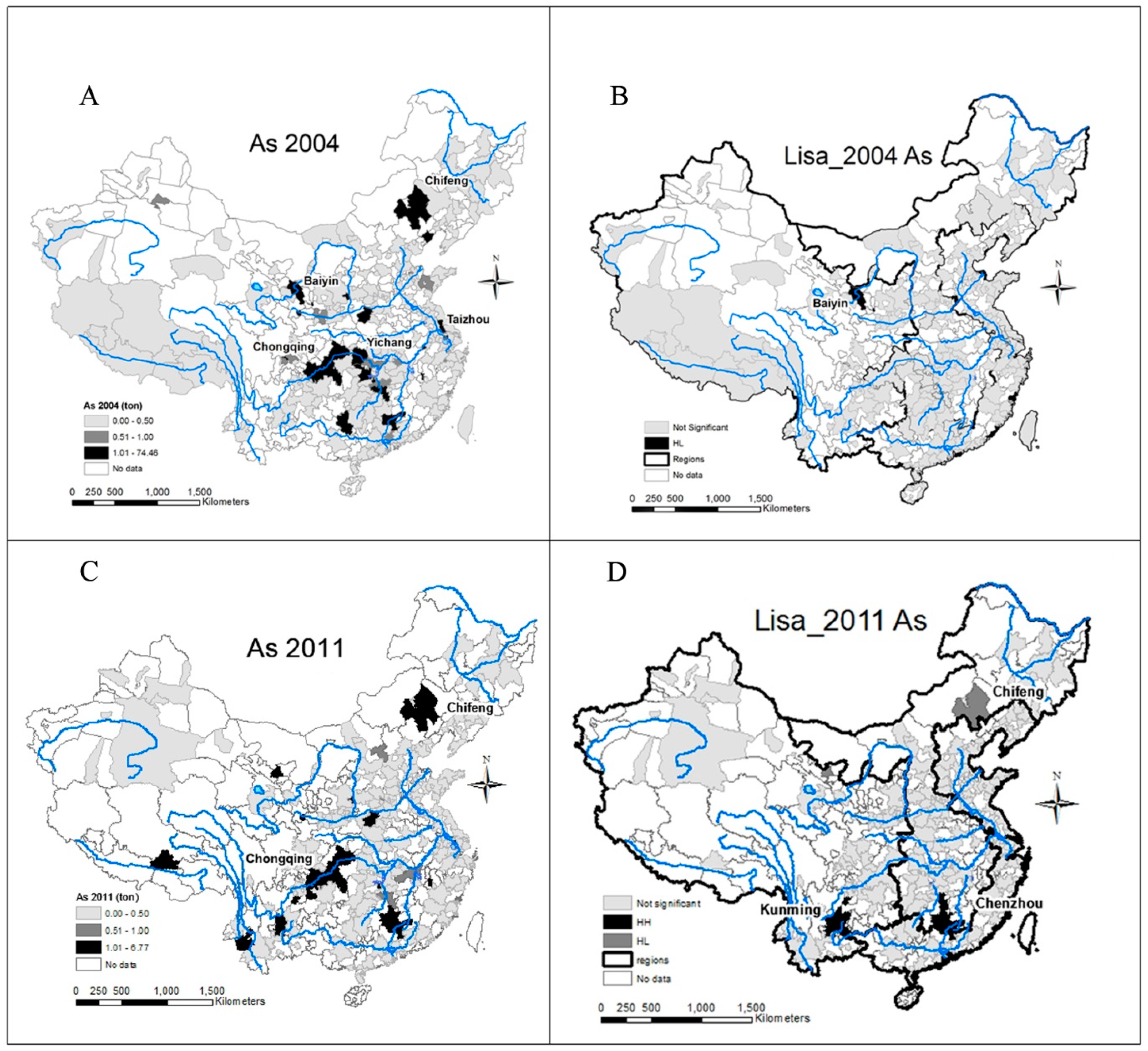
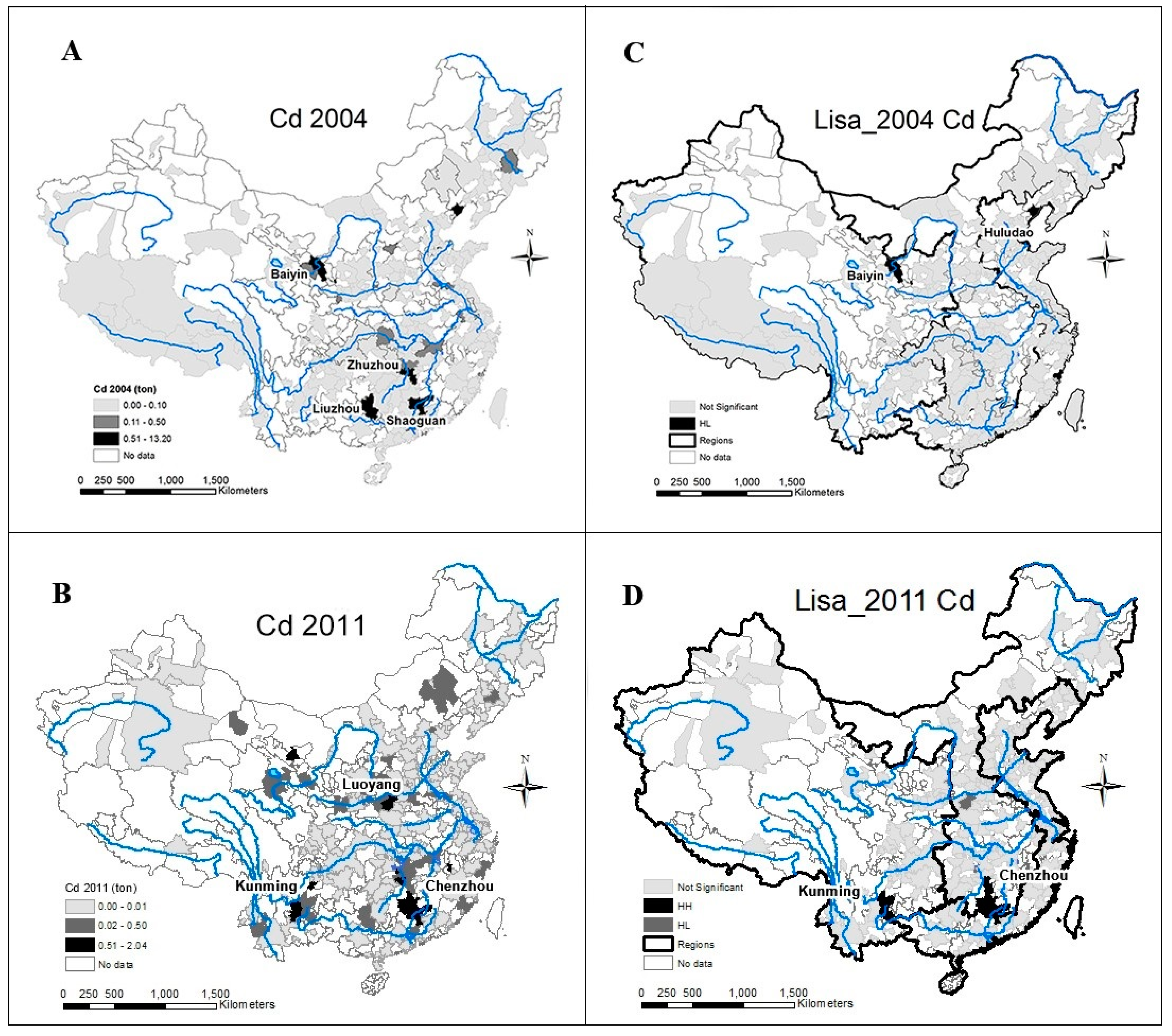
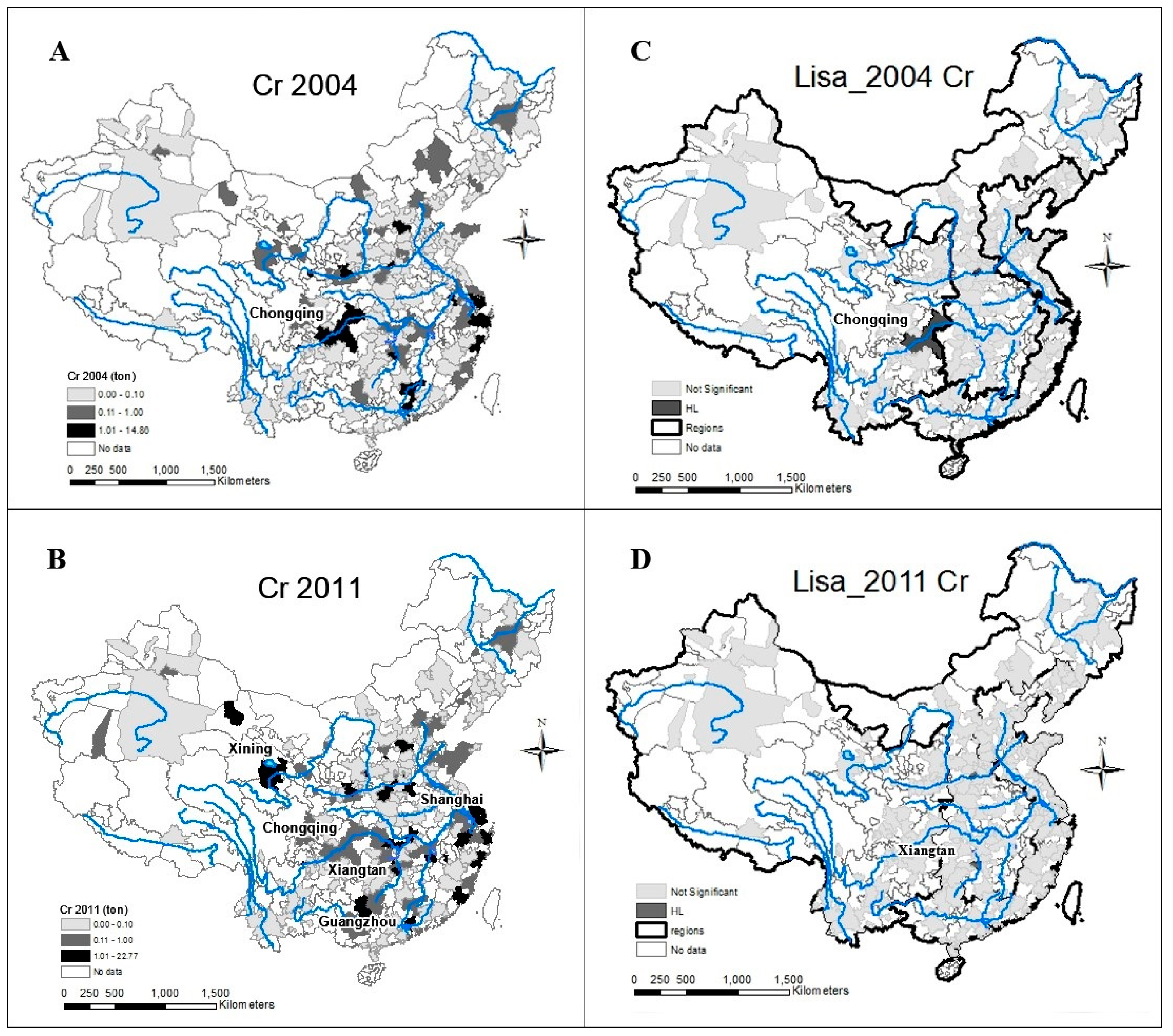

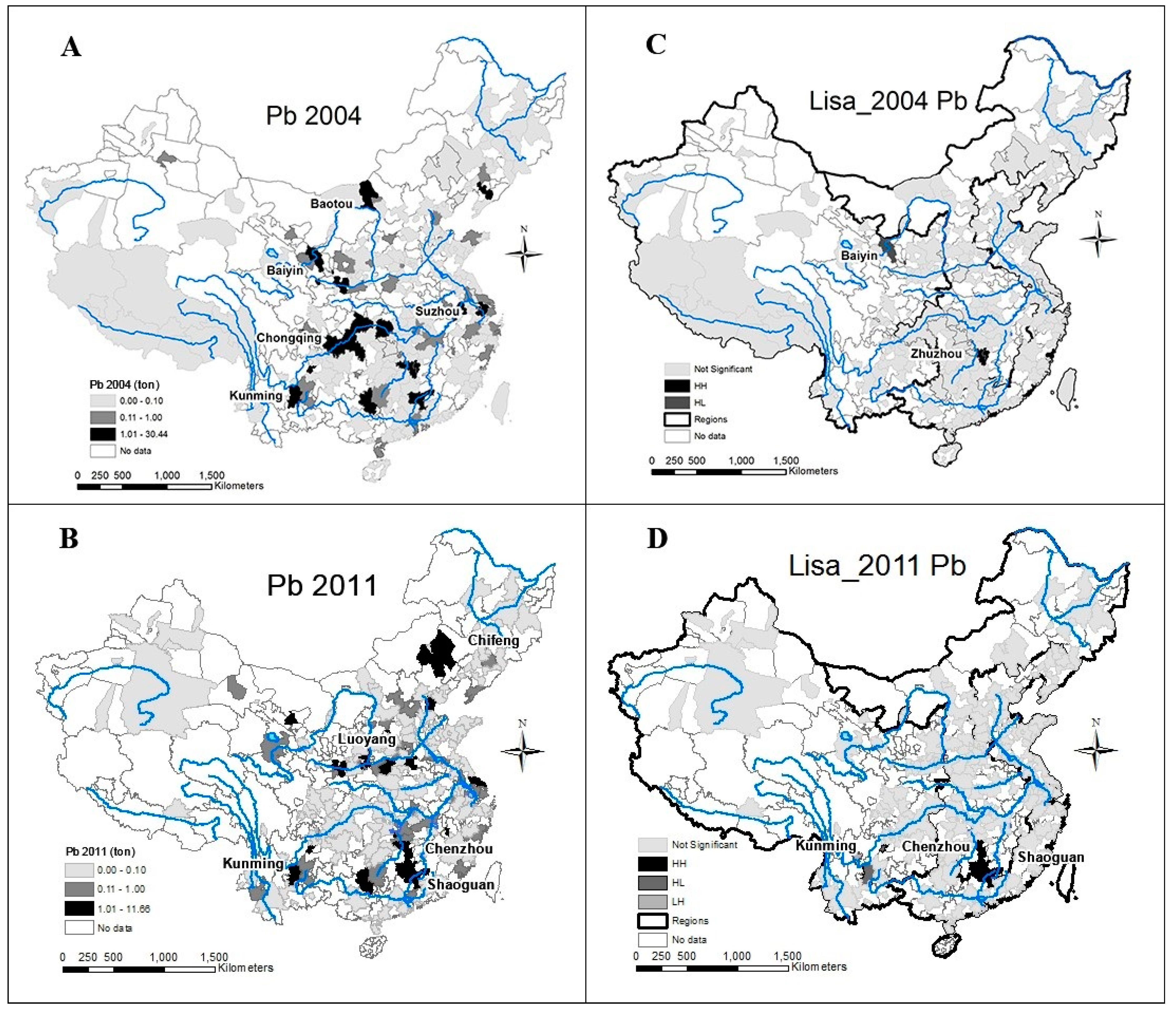
3.2. Socioeconomic Transitions, Physical Conditions, and Heavy Metal Water Pollution
3.2.1. Heavy Metal Water Pollution Estimation Using Kriging and Model Validation
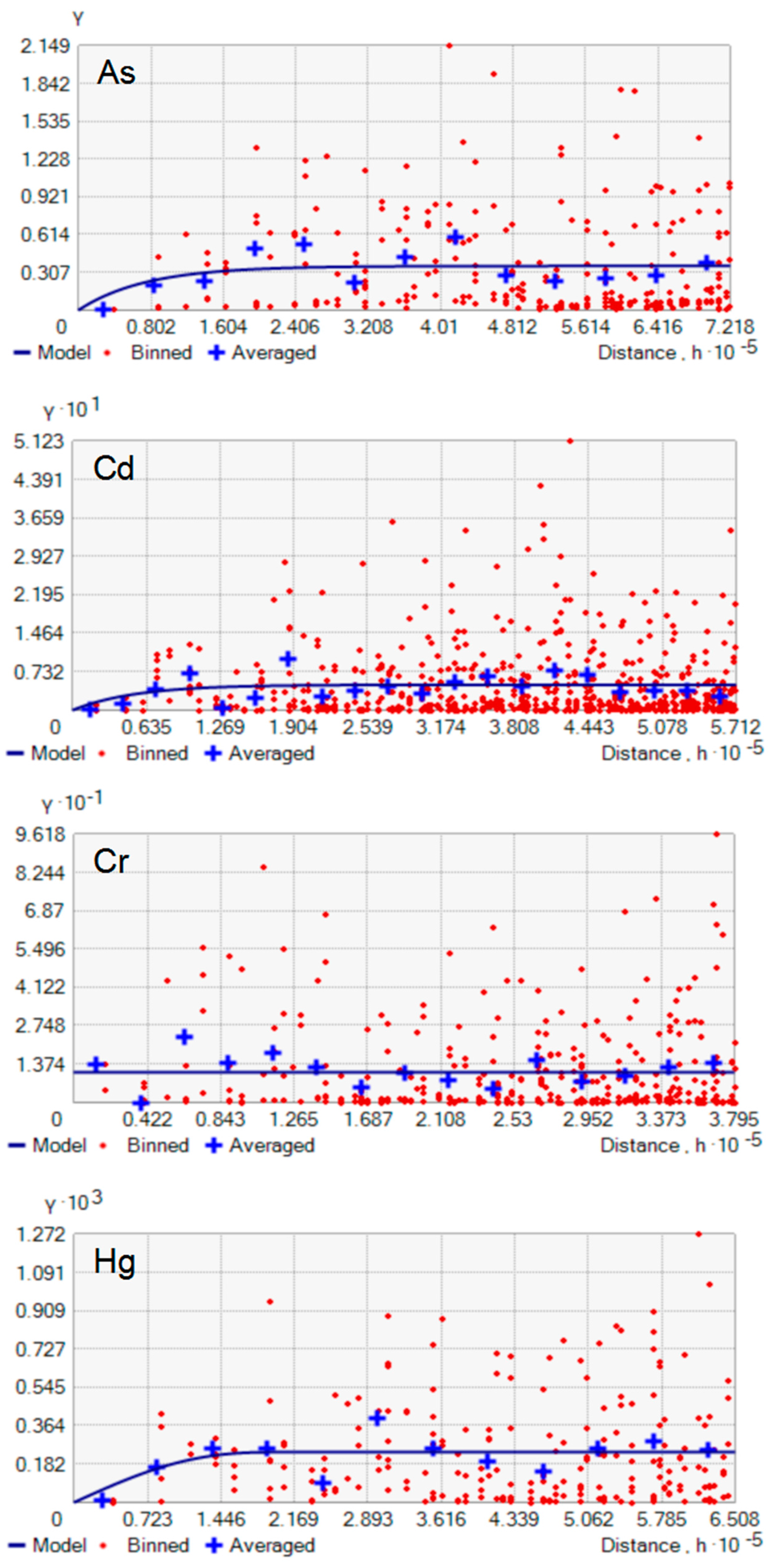
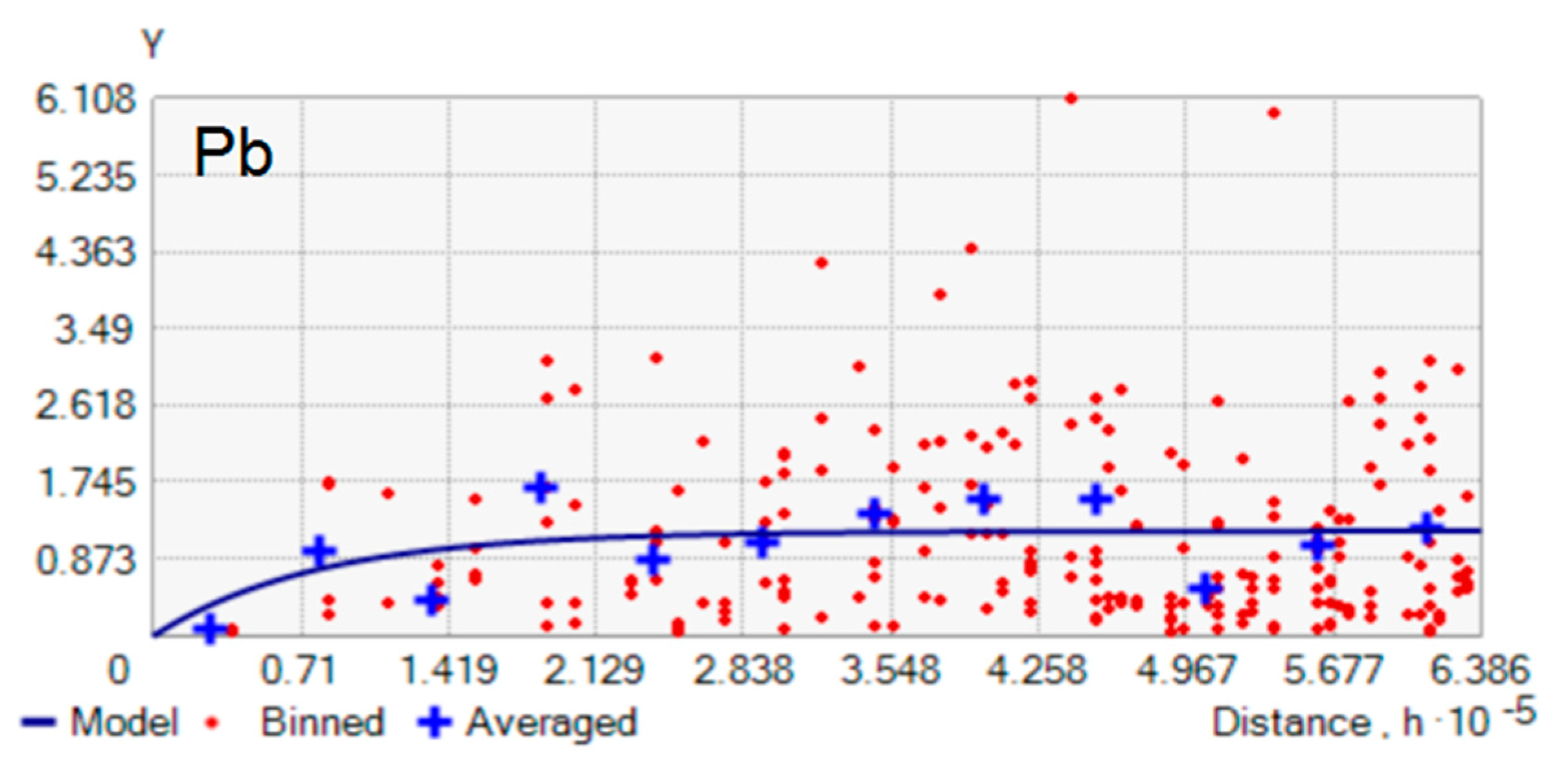
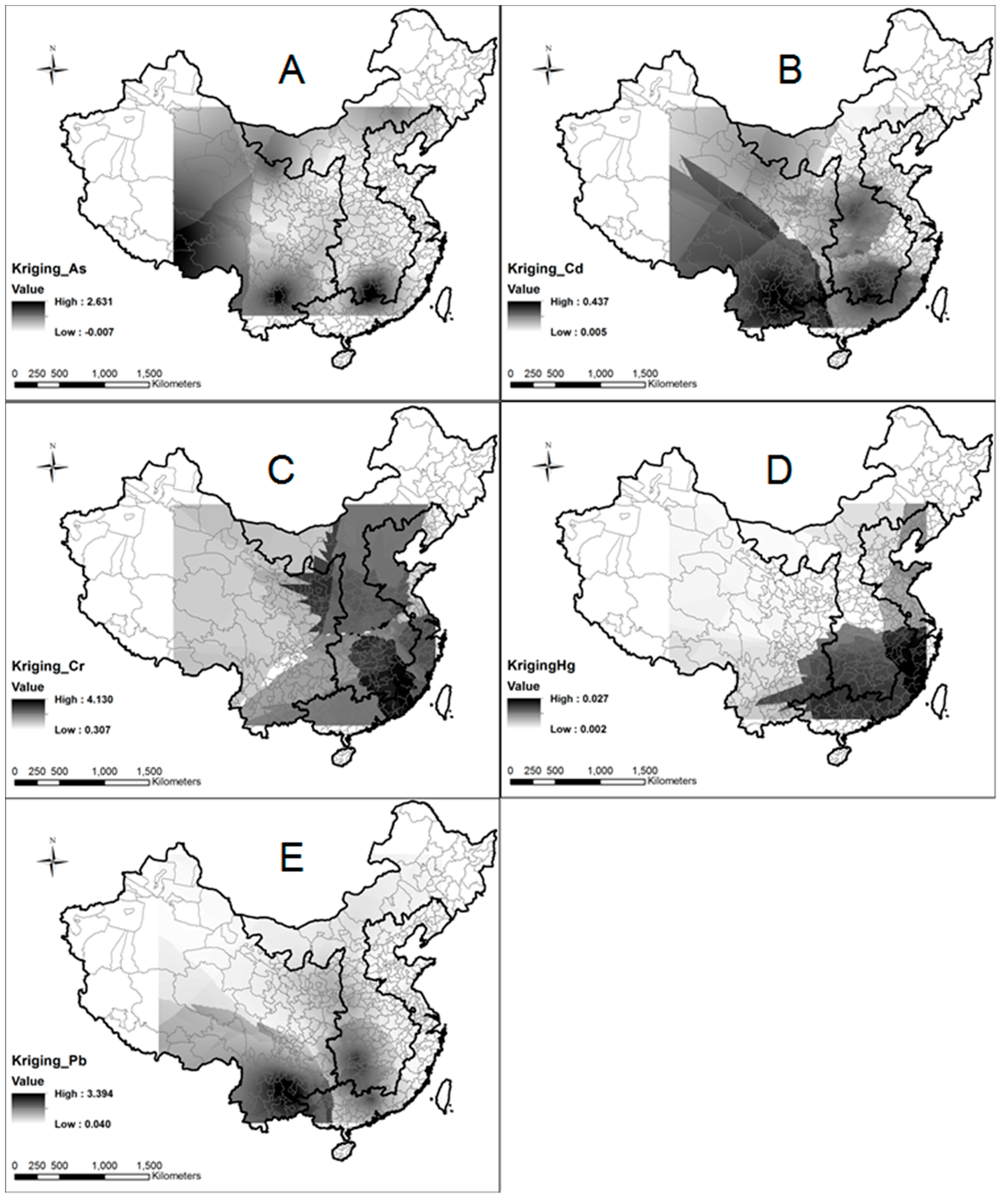
| Heavy Metals | As | Cd | Cr | Hg | Pb |
|---|---|---|---|---|---|
| Kriging method | Universal | Ordinary | Ordinary | Universal | Universal |
| Kernel function | Exponential | Exponential | Exponential | Exponential | Exponential |
| Lag size | 55,523 | 28,562 | 25,300 | 54,236 | 53,220 |
| Number lags | 13 | 20 | 15 | 12 | 12 |
| Order of trend removal | Constant | Constant | Second | Second | Constant |
| Anisotropy | False | False | False | False | False |
| Semivariogram model | Exponential | Exponential | Spherical | Pentaspherical | Exponential |
| Number of observed points | 77 | 58 | 97 | 39 | 87 |
| Mean error | 0.003 | −0.002 | −0.002 | −0.033 | −0.004 |
| RMSE | 0.829 | 0.235 | 2.828 | 0.968 | 1.222 |
| Average standard error | 0.551 | 0.212 | 3.327 | 0.015 | 0.994 |
| p-value | 0.94 | 0.97 | 0.92 | 0.89 | 0.98 |
3.2.2. OLS Regression Results
| Independent Variables | Coefficient (As) | Coefficient (Cd) | Coefficient (Cr) | Coefficient (Hg) | Coefficient (Pb) | |
|---|---|---|---|---|---|---|
| Control Variables | Intercept | 1.501 *** | 0.216 *** | 2.253 *** | 0.010 * | 0.984 ** |
| Treatment Rate | −0.013 *** | −0.001 | −0.004 | 0.000 | −0.004 | |
| Heavy metals in 2004 | 0.053 ** | 0.050 ** | 0.033 | 0.006 | 0.056 *** | |
| Socioeconomic Transitions | Mining & Quarrying (MQ) | 0.017 | 0.003 | −0.013 | −0.000 | 0.016 |
| Enterprises (IND) | 0.152 *** | 0.007 | −0.125 | −0.001 | 0.132 ** | |
| Transportation (TRA) | −0.000 | 0.000 * | −0.000 | 0.000 | −0.000 | |
| Urbanization (URB) | −0.550 ** | −0.103 ** | −0.112 | −0.003 | −0.397 | |
| Globalization (GLO) | 0.000 | −0.000 | −0.000 | −0.000 | 0.000 | |
| Economy (ECO) | 0.000 | −0.000 * | 0.000 | 0.000 | −0.000 | |
| Physical conditions | Natural resources (NR) | 0.000 ** | 0.000 *** | −0.030 *** | −0.000*** | 0.003 *** |
| Green coverage rate (GRE) | 0.031 | 0.006 | 0.009 | 0.001 | 0.062 | |
| Hydrology (HYD) | −0.037 | 0.007 | −0.063 | 0.000 | −0.067 | |
| Significance F | 0.00 *** | 0.00 *** | 0.00 *** | 0.00*** | 0.00 *** | |
| R-square | 0.30 | 0.34 | 0.17 | 0.29 | 0.30 |
4. Conclusions
Acknowledgments
Author Contributions
Conflicts of Interest
References
- World Resource Institute. 2007. Available online: http://www.wri.org/publication/wri-annual-report-2006–2007 (accessed on 21 April 2014).
- Bao, L.-J.; Maruya, K.A.; Snyder, S.A.; Zeng, E.Y. China’s water pollution by persistent organic pollutants. Environ. Pollut. 2012, 163, 100–108. [Google Scholar] [CrossRef] [PubMed]
- Hu, Y.; Cheng, H. Water pollution during China’s industrial transition. Environ. Dev. 2013, 8, 57–73. [Google Scholar] [CrossRef]
- Ministry of Water Resources of China (MWR). China Country Report on Sustainable Development-Water Resources; Ministry of Water Resources, People’s Republic of China: Beijing, China, 2003.
- Ministry of Water Resources of China (MWR). China Water Resources Bulletin; Ministry of Water Resources, People’s Republic of China: Beijing, China, 2012.
- Liu, J.; Diamond, J. China’s environment in a globalizing world. Nature 2005, 435, 1179–1186. [Google Scholar] [CrossRef] [PubMed]
- Carr, R.; Zhang, C.; Moles, N.; Harder, M. Identification and mapping of heavy metal pollution in soils of a sports ground in Galway City, Ireland, using a portable XRF analyser and GIS. Environ. Geochem. Health 2008, 30, 45–52. [Google Scholar] [CrossRef] [PubMed]
- Liu, L. Made in China: cancer villages. Environ. Sci. Policy Sustain. Dev. 2010, 52, 8–21. [Google Scholar] [CrossRef]
- Watts, J. Lead poisoning cases spark riots in China. Lancet 2009. [Google Scholar] [CrossRef]
- Hu, H.; Jin, Q.; Kavan, P. A study of heavy metal pollution in China: Current status, pollution-control policies and countermeasures. Sustainability 2014, 6, 5820–5838. [Google Scholar] [CrossRef]
- Zhai, L.; Liao, X.; Chen, T.; Yan, X.; Xie, H.; Wu, B.; Wang, L. Regional assessment of cadmium pollution in agricultural lands and the potential health risk related to intensive mining activities: A case study in Chenzhou City, China. J. Environ. Sci. 2008, 20, 696–703. [Google Scholar] [CrossRef]
- Ebenstein, A. The consequences of industrialization: Evidence from water pollution and digestive cancers in China. Rev. Econ. Stat. 2012, 94, 186–201. [Google Scholar] [CrossRef]
- Lee, C.-C.; Chiu, Y.-B.; Sun, C.-H. The environmental Kuznets curve hypothesis for water pollution: Do regions matter? Energy Policy 2010, 38, 12–23. [Google Scholar] [CrossRef]
- Schwarzenbach, R.P.; Egli, T.; Hofstetter, T.B.; von Gunten, U.; Wehrli, B. Global water pollution and human health. Ann. Rev. Environ. Resour. 2010, 35, 109–136. [Google Scholar] [CrossRef]
- Jiang, J.; Wang, P.; Lung, W.; Guo, L.; Li, M. A GIS-based generic real-time risk assessment framework and decision tools for chemical spills in the river basin. J. Hazard. Mater. 2012, 227, 280–291. [Google Scholar] [CrossRef] [PubMed]
- Sheng, J.; Wang, X.; Gong, P.; Tian, L.; Yao, T. Heavy metals of the Tibetan top soils. Environ. Sci. Pollut. Res. 2012, 19, 3362–3370. [Google Scholar] [CrossRef] [PubMed]
- Wang, S.-L.; Xu, X.-R.; Sun, Y.-X.; Liu, J.-L.; Li, H.-B. Heavy metal pollution in coastal areas of South China: A review. Mar. Pollut. Bull. 2013, 76, 7–15. [Google Scholar]
- Jia, Y.; Bai, Q.; Xiao, H. Investigation of the status of chromium pollution at an electroplating industrial area in Chongqing. Modern Prev. Med. 2014, 6, 978–980. [Google Scholar]
- Zhong, L.; Liu, L.; Yang, J. Characterization of heavy metal pollution in the paddy soils of Xiangyin County, Dongting lake drainage basin, central south China. Environ. Earth Sci. 2012, 67, 2261–2268. [Google Scholar] [CrossRef]
- Meng, W.; Qin, Y.; Zheng, B.; Zhang, L. Heavy metal pollution in Tianjin Bohai bay, China. J. Environ. Sci. 2008, 20, 814–819. [Google Scholar] [CrossRef]
- Yang, T.; Liu, J. Health Risk Assessment and Spatial Distribution Characteristic on Heavy Metals Pollution of Haihe River Basin. J. Environ. Anal. Toxicol. 2012, 2, 152. [Google Scholar] [CrossRef]
- Huang, F.; Wang, X.; Lou, L.; Zhou, Z.; Wu, J. Spatial variation and source apportionment of water pollution in Qiantang River (China) using statistical techniques. Water Res. 2010, 44, 1562–1572. [Google Scholar] [CrossRef] [PubMed]
- Madkour, H.A. Distribution and relationships of heavy metals in the giant clam (Tridacna maxima) and associated sediments from different sites in the Egyptian Red Sea coast. Egypt. J. Aqua. Res. 2005, 31, 45–59. [Google Scholar]
- Wei, B.; Yang, L. A review of heavy metal contaminations in urban soils, urban road dusts and agricultural soils from China. Microch. J. 2010, 94, 99–107. [Google Scholar] [CrossRef]
- Li, Y.; Wei, D.Y. The spatial-temporal hierarchy of regional inequality of China. Appl. Geogr. 2010, 30, 303–316. [Google Scholar] [CrossRef]
- Wang, M.M.; Webber, B.F; Barnett, J. Rural industries and water pollution in China. J. Environ. Manage. 2008, 86, 648–659. [Google Scholar] [CrossRef] [PubMed]
- DeCatanzaro, R.; Cvetkovic, M.; Chow-Fraser, P. The relative importance of road density and physical watershed features in determining coastal marsh water quality in Georgian Bay. Environ. Manage. 2009, 44, 456–467. [Google Scholar] [CrossRef] [PubMed]
- Feng, J.; Zhao, J.; Bian, X.; Zhang, W. Spatial distribution and controlling factors of heavy metals contents in paddy soil and crop grains of rice–wheat cropping system along highway in East China. Environ. Geochem. Health 2012, 34, 605–614. [Google Scholar] [CrossRef] [PubMed]
- He, C.; Huang, Z.; Ye, X. Spatial heterogeneity of economic development and industrial pollution in urban China. Stoch. Environ. Res. Risk Assess. 2014, 28, 767–781. [Google Scholar] [CrossRef]
- Christmann, P.; Taylor, G. Globalization and the environment: Determinants of firm self-regulation in China. J. Int. Bus. Stud. 2001, 32, 439–458. [Google Scholar] [CrossRef]
- He, C.; Pan, F.; Yan, Y. Is economic transition harmful to China’s urban environment? Evidence from industrial air pollution in Chinese cities. Urban. Stud. 2012, 49, 1767–1790. [Google Scholar] [CrossRef]
- Alexander, R.B.; Boyer, E.W.; Smith, R.A.; Schwarz, G.E.; Moore, R.B. The role of headwater streams in downstream water quality. JAWRA J. Am. Water Resour. Assoc. 2007, 43, 41–59. [Google Scholar] [CrossRef] [PubMed]
- Liu, Z.; Li, Y.; Li, Z. Surface water quality and land use in Wisconsin, USA—A GIS approach. J. Integr. Environ. Sci. 2009, 6, 69–89. [Google Scholar] [CrossRef]
- Li, Z.; Ma, Z.; van der Kuijp, T.J.; Yuan, Z.; Huang, L. A review of soil heavy metal pollution from mines in China: Pollution and health risk assessment. Sci. Total Environ. 2014, 468, 843–853. [Google Scholar] [CrossRef] [PubMed]
- Li, Y.; Wei, D.Y. A spatial-temporal analysis of health care and mortality inequalities in China. Eurasian Geogr. Econ. 2010, 51, 767–787. [Google Scholar] [CrossRef]
- Dhakal, S. Urban energy use and carbon emissions from cities in China and policy implications. Energy Policy 2009, 37, 4208–4219. [Google Scholar] [CrossRef]
- China Statistical Yearbook; Beijing, China, 2005.
- Institute of Public & Environmental Affairs. Available online: http://www.ipe.org.cn/pollution/status.aspx (accessed on 21 May 2013).
- China Data Center. Available online: http://chinadatacenter.org/ (accessed on 21 May 2013).
- Anselin, L. Local indicators of spatial association-LISA. Geogr. Anal. 1995, 27, 93–115. [Google Scholar] [CrossRef]
- Fotheringham, A.S.; Brunsdon, C.; Charlton, M. Geographically Weighted Regression: The Analysis of Spatially Varying Relationships; John Wiley & Sons: West Sussex, UK, 2003. [Google Scholar]
- Li, X.; Cheng, G.; Lu, L. Spatial analysis of air temperature in the Qinghai-Tibet Plateau. Arct. Antarct. Alp. Res. 2005, 37, 246–252. [Google Scholar] [CrossRef]
- Yang, J.S.; Wang, Y.Q.; August, P.V. Estimation of land surface temperature using spatial interpolation and satellite-derived surface emissivity. J. Environ. Inform. 2004, 4, 37–44. [Google Scholar] [CrossRef]
- Simasuwannarong, B.; Satapanajaru, T.; Khuntong, S.; Pengthamkeerati, P. Spatial distribution and risk assessment of As, Cd, Cu, Pb, and Zn in topsoil at Rayong Province, Thailand. Water Air Soil Pollut. 2012, 223, 1931–1943. [Google Scholar] [CrossRef]
- Wu, T.; Li, Y. Spatial interpolation of temperature in the United States using residual kriging. Appl. Geogr. 2013, 44, 112–120. [Google Scholar] [CrossRef]
- United States Geological Survey. Arsenic. Available online: http://minerals.er.usgs.gov/minerals/pubs/commodity/arsenic/mcs-2008-arsen.pdf (accessed on 7 July 2014).
- Sun, G. Arsenic contamination and arsenicosis in China. Toxicol. Appl. Pharmacol. 2004, 198, 268–271. [Google Scholar] [CrossRef] [PubMed]
- Xiao, X.; Chen, T.; Liao, X.; Wu, B.; Yan, X.; Zhai, L.; Xie, H.; Wang, L. Regional distribution of arsenic contained minerals and arsenic pollution in China. Geogr. Res. 2008, 1, 021. [Google Scholar]
- Rodríguez-Lado, L.; Sun, G.; Berg, M.; Zhang, Q.; Xue, H.; Zheng, Q.; Johnson, C.A. Groundwater arsenic contamination throughout China. Science 2013, 341, 866–868. [Google Scholar] [CrossRef] [PubMed]
- Wen, D.; Zhang, F.; Zhang, E.; Wang, C.; Han, S.; Zheng, Y. Arsenic, fluoride and iodine in groundwater of China. J. Geochem. Explor. 2013, 135, 1–21. [Google Scholar] [CrossRef]
- Singh, B.R.; McLaughlin, M.J. Cadmium in Soils and Plants; Springer: Dordrecht, The Netherlands, 1999. [Google Scholar]
- Liu, S.J.; Ou, L.M. Status of zinc smelting in China. Conserv. Util. Mine Res. 2003, 6, 36–40. [Google Scholar]
- Lei, M.; Zeng, M.; Zheng, Y.M.; Liao, M.H.; Zhu, Y. Heavy metals pollution and potential ecological risk in paddy soils around mine areas and smelting areas in Hunan Province. Acta Sci. Circumst. 2008, 28, 1212–1220. [Google Scholar]
- Cheng, S. Heavy metal pollution in China: Origin, pattern and control. Environ. Sci. Pollut. Res. 2003, 10, 192–198. [Google Scholar] [CrossRef]
- Rong, W.; Zhou, Q. Soil pollution processes, their affecting factors, and phytoremediation of chromium slag heads: A review. Chin. J. Ecol. 2010, 29, 598–604. [Google Scholar]
- Jiang, G.-B.; Shi, J.-B.; Feng, X.-B. Mercury pollution in China. Environ. Sci. Technol. 2006, 40, 3672–3678. [Google Scholar] [CrossRef]
- Hu, D.; Zhang, W.; Tong, Y.; Wang, X. China Counties Mercury discharge investigation. http://cpfd.cnki.com.cn/Article/CPFDTOTAL-ZGDQ201107001154.htm. (accessed 1 October 2014).
- Wu, L.; Zhao, D.; Zhang, D.; Wang, Z.; Zhang, X. Concentration and fluxes of total mercury at a forest catchment and an urban area in Chongqing City. Resour. Environ. Yangtze Basin 2006, 15, 399–404. [Google Scholar]
- Ding, X.; Chen, L.; Zhang, W.; Xu, Z.; Peng, X.; Shang, L. Preliminary Study on Pollution Status and Assessment of Mercury in Sediment from the Beijiang River. J. Agro-Environ. Sci. 2010, 2, 357–362. [Google Scholar]
- Zhang, Z.; Li, D.; Xu, Z. Present Conditions, Reasons and Measures of Lead Pollution in China. Environ. Protect. Sci. 2005, 4, 41–42. [Google Scholar]
- Zhang, X.; Yang, L.; Li, Y.; Li, H.; Wang, W.; Ye, B. Impacts of lead/zinc mining and smelting on the environment and human health in China. Environ. Monit. Assess. 2012, 184, 2261–2273. [Google Scholar] [CrossRef] [PubMed]
- Lin, Y. Pollution of Jinjian Copper in Chifeng City caused local residents abnormal blood lead levels. Available online: http://hj.ce.cn/gdxw/201309/12/t20130912_1091113.shtml (accessed on 12 December 2014).
- Bale, R. China’s other pollution problem-its soil. The Center for Investigative Reporting. http://www.environmentmagazine.org/Archives/Back%20Issues/March-April%202010/made-in-china-full.html (accessed on 25 October 2014).
- Tan, D. Heavy Metals & Agriculture. China Water Risk Review. http://chinawaterrisk.org/resources/analysis-reviews/heavy-metals-agriculture/ (accessed on 30 July 2014).
- Wen, B.; Yang, L. A review of heavy metal contaminations in urban soils, urban road dusts and agricultural soils from China. Microchem. J. 2010, 94, 99–107. [Google Scholar]
- United Nations Environment Program. Minamata Convention Agreed by Nations. Available online: http://www.unep.org/newscentre/default.aspx?DocumentID=2702&ArticleID=9373 (accessed on 10 June 2014).
- Cole, S. Foxconn building 500K iPhone 5s units for Apple per day with nonstop production lines. Available online: http://appleinsider.com/articles/13/11/27/foxconn-building-500k-iphone-5s-units-for-apple-per-day-with-nonstop-production-lines (accessed on 14 December 2014).
- Stanway, D. The Obstacle to Treating China’s Contaminated Soil is Finding Someone to Pay. Available online: http://uk.reuters.com/article/2014/09/16/us-china-pollution-soil-idUKKBN0HB2IX20140916 (accessed on 12 December 2014).
- Changde Bureau of Land and Resources. The Overall Plan of Mineral Resources. http://gtj.changde.gov.cn/art/2011/1/17/art_29010_726293.html (accessed on 1 December 2014).
- Liu, J.; Zhang, X.-H.; Tran, H.; Wang, D.-Q.; Zhu, Y.-N. Heavy metal contamination and risk assessment in water, paddy soil, and rice around an electroplating plant. Environ. Sci. Pollut. Res. 2011, 18, 1623–1632. [Google Scholar] [CrossRef] [PubMed]
- Wang, Y.; Wang, P.; Bai, Y.; Tian, Z.; Li, J.; Shao, X.; Mustavich, L.F.; Li, B.-L. Assessment of surface water quality via multivariate statistical techniques: A case study of the Songhua River Harbin region, China. J. Hydro-Environ. Res. 2013, 7, 30–40. [Google Scholar] [CrossRef]
© 2015 by the authors; licensee MDPI, Basel, Switzerland. This article is an open access article distributed under the terms and conditions of the Creative Commons Attribution license (http://creativecommons.org/licenses/by/4.0/).
Share and Cite
Li, H.; Li, Y.; Lee, M.-K.; Liu, Z.; Miao, C. Spatiotemporal Analysis of Heavy Metal Water Pollution in Transitional China. Sustainability 2015, 7, 9067-9087. https://doi.org/10.3390/su7079067
Li H, Li Y, Lee M-K, Liu Z, Miao C. Spatiotemporal Analysis of Heavy Metal Water Pollution in Transitional China. Sustainability. 2015; 7(7):9067-9087. https://doi.org/10.3390/su7079067
Chicago/Turabian StyleLi, Huixuan, Yingru Li, Ming-Kuo Lee, Zhongwei Liu, and Changhong Miao. 2015. "Spatiotemporal Analysis of Heavy Metal Water Pollution in Transitional China" Sustainability 7, no. 7: 9067-9087. https://doi.org/10.3390/su7079067
APA StyleLi, H., Li, Y., Lee, M.-K., Liu, Z., & Miao, C. (2015). Spatiotemporal Analysis of Heavy Metal Water Pollution in Transitional China. Sustainability, 7(7), 9067-9087. https://doi.org/10.3390/su7079067






